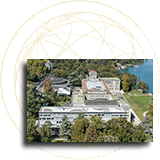- home
- the wto
- the wto building
- justification
THE WTO: BUILDING
Justification for the project
There are several reasons for a complete and comprehensive renovation of the CWR and a new addition to the WTO headquarters. The main reasons are related to the ever increasing activities and membership of the WTO, along with the increase in the number of Secretariat staff. Other reasons have to do with the age and physical structure of the CWR.
Disclaimer
The content of these pages may not be transmitted or reproduced
without the prior written permission of the Chairman of the Renovation
Task Force, WTO 154 rue de Lausanne, CH-1211 Gen鑦e 21. The drawings,
blueprints, and illustrations on this site represent a view of how the
building could look like after the renovation/construction. They do not
necessarily give a final image of the end result, and are subject to
approval according to local and Swiss laws and regulations. The written descriptions,
statements or comments are purely indicative and may not reflect the
official views of the WTO, its Members or its Secretariat.
Since its completion in 1926, the CWR has hosted numerous occupants
and undergone several modifications and expansions. Within 10 years of
its completion, the original CWR already proved too small and wings
were added to the north and south. By 1957, two further wings
completed the south quadrangle and a third floor was added on the
north wing. From its completion in 1926 to 1975, the CWR hosted the
ILO Headquarters and from 1977 the GATT, the UNHCR and the Graduate
Institute of International Studies Library shared the current
facilities. In 1995 the WTO became the main occupant of the CWR, but
even at that time it was clear that the building was too small to
accommodate all WTO staff. In fact, since its birth in 1995 the WTO
has always had to rent additional space outside the CWR to house a
large number of staff. From an organizational as well as efficiency
point of view this situation is far from ideal and for staff as well
as for our Members a single-site WTO is a more logical and practical
solution for our space needs.
Since the creation of the GATT in 1948, the multilateral trading
system has changed from a relatively small and exclusive club of 23
countries to a truly universal organization of 152 Members. In the 13
years since the birth of the WTO, membership has increased by almost
20%. Similarly, the WTO's agenda is now much broader and incorporates,
among other things, a much expanded mandate to provide technical
assistance to developing countries that make up two-thirds of the WTO
membership. Servicing a larger and more diverse membership continues
to place ever more comprehensive demands on the WTO Secretariat staff.
Assuming even a modest annual growth rate of 1%, the WTO Secretariat
would house a staff of approximately 830 by 2013 and over 1100 by
2040. Needless to say, our current facilities would not be adequate to
accommodate this number of staff.
